#biblicalGreek
Explore tagged Tumblr posts
Text
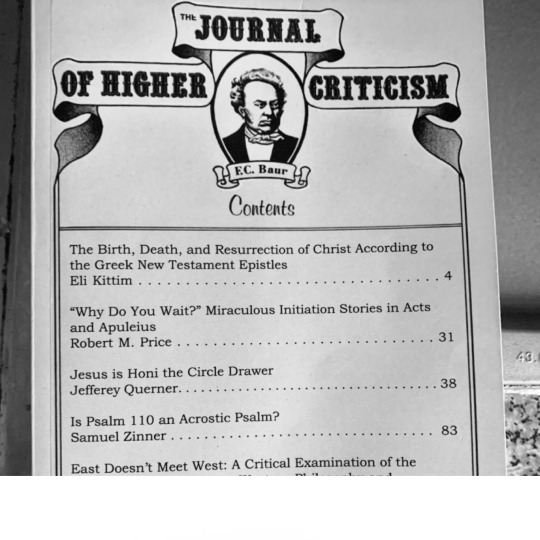
What if the Crucifixion of Christ is a Future Event?
Read the PDF of my article, published in the Journal of Higher Criticism, vol. 13, no. 3 (2018).
#What_if_the_Crucifixion_of_Christ_is_a_Future_Event#theStudyoftheHistoricalJesus#historicalJesusstudies#NewTestamentGreek#TheJournalofHigherCriticism#endtimes#academic journals#biblicalhermeneutics#septuagint#koine greek#LXX#biblical theology#biblical hebrew#EliKittim#christology#lastdays#thelittlebookofrevelation#historicalcriticism#biblical studies#bibleprophecy#TheEndoftheAge#biblicalGreek#Ελικιτιμ#open access journals#bibleresearch#τομικροβιβλιοτηςαποκαλυψης#Christianeschatology#academic article#bible translation#The_Birth_Death_and_Resurrection_of_Christ_According_to_the_Greek_New_Testament_Epistles
1 note
·
View note
Text
#biblegreek #exegesis
0 notes
Photo

Some wrongly-called "messianic" cults believe that the New Testament was originally written in Hebrew because "Jews would never use a Pagan language like Greek." Unfortunately for them, the evidence shows that Jews even produced a Greek translation of the Old Testament. The New Testament WAS written in Greek, the common language of the first century, in order to reach all nations with a Gospel which was meant for "every creature," as per our Lord's instructions (Mark 16:15–16). #falsemessianics #Hebrewroots #Jewishroots #judaizers #Septuagint #HebrewBible #BiblicalGreek https://www.instagram.com/p/CGqkB46Acle/?igshid=bg5rfyqa4owg
2 notes
·
View notes
Text
A Week in Review: 1/6/2019-1/12/2019
What is new at Anderson Theology this week:
The Ante-Nicene Fathers (A.D. 100-325) page updated.
Clement of Alexandria (c. A.D. 150 – c. 215) page updated.
Irenaeus of Lyons (c. A.D. 130 – c. 200) page updated.
Marcion of Sinope (d. c. A.D. 160) page created.
Montanus page created.
Tertullian (c. A.D. 160 – c. 225) page created.
The Reformation Theologians (A.D. 1517-1648) page updated.
John…
View On WordPress
#Abel#Adam#AndersonTheology#BiblicalGreek#BiblicalHebrew#BiblicalPeople#BiblicalTheology#Cain#ClementOfAlexandria#EThomasAnderson#Eve#HistoricalTheology#IrenaeusOfLyons#JohnEliot#KingCyrusII#KingDariusI#MarcionOfSinope#Montanus#Tertullian#TheAnteNiceneFathers#TheReformationTheologians
2 notes
·
View notes
Photo
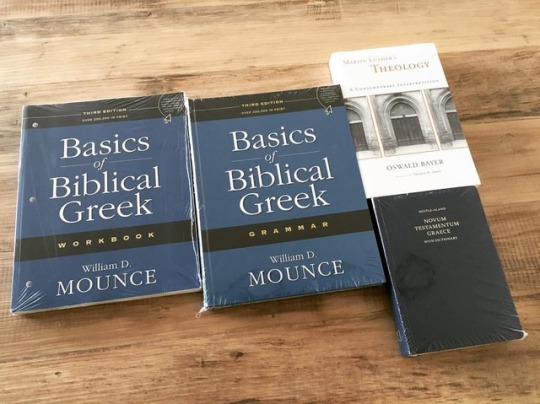
Inner geek is EXCITED for the upcoming semester! #koinegreek #greek #biblicalgreek #novumtestamentumgraece
2 notes
·
View notes
Text
Greek to Me (Paperback)
Greek to Me (Paperback)
Master New Testament BiblicalGreek with the 2nd Edition of the Greek To Me™ textbook. The Greek To Me™ textbook is the cornerstone tool in the Greek To Me™ learning system.
The 2nd Edition of the Greek To Me™ textbook features:
24 CHAPTERS OF BIBLICAL GREEK GRAMMAR INSTRUCTION
The Greek To Me™ textbook features a building block approach to learning the nuances of Biblical Greek. You’ll begin…
View On WordPress
1 note
·
View note
Text
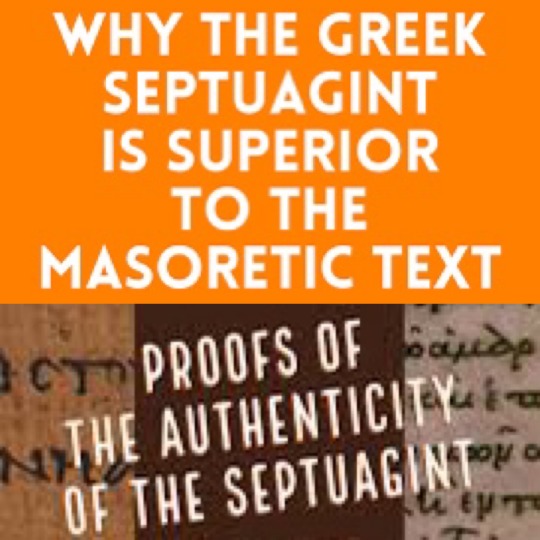
Was the Septuagint Destroyed When the Library of Alexandria Was Burnt Down in 48 BC?
By Author Eli Kittim 🎓
The Argument
Some people (typically Jewish apologists) claim that the Septuagint doesn’t exist because it was destroyed when the Library of Alexandria was burnt down in 48 BC.
This conclusion, however, is both textually misleading & historically erroneous.
First
The Alexandrian Library and its collection were not entirely destroyed. We have evidence that there was only partial damage and that many of its works survived. According to Wiki:
The Library, or part of its collection, was
accidentally burned by Julius Caesar during
his civil war in 48 BC, but it is unclear how
much was actually destroyed and it seems
to have either survived or been rebuilt
shortly thereafter; the geographer Strabo
mentions having visited the Mouseion in
around 20 BC and the prodigious scholarly
output of Didymus Chalcenterus in
Alexandria from this period indicates that
he had access to at least some of the
Library's resources.
Second
The Septuagint had already been written and disseminated among the diaspora since the 3rd century BC, and so many of its extant copies were not housed in the Library of Alexandria per se.
Third
Textual Criticism confirms that the New Testament authors used the Septuagint predominantly and quoted extensively from it. If the Septuagint didn’t exist, where did the New Testament authors copy from? And how do you explain the fact that the New Testament and the Septuagint often have identical wording in their agreements?
Fourth
The Dead Sea Scrolls also demonstrate that the Septuagint was far more accurate than the 10th-century-AD Masoretic text. See, for example, the textual controversy surrounding Deuteronomy 32:8. Both the Dead Sea Scrolls and the Septuagint have “sons of God.” The Masoretic text is demonstrably inaccurate because it has “sons of Israel,” a later redaction. Israel didn’t even exist at that time!
Fifth
Emanuel Tov, a leading authority on the Septuagint who has explained the various textual families (or text-types) of the Old Testament, never once mentioned that we lost the Septuagint, or that it was destroyed, or that it was no longer in circulation. On the contrary, he claims that it continued to be in use during the Christian period and that it is much more older than the 10th-century-AD Masoretic text, which the Jews call the “Hebrew Bible.”
Sixth
If the Septuagint was completely destroyed, as some have erroneously suggested, from where were the later revisionists and translators copying from? We have historical evidence that they were, in fact, copying from the Septuagint itself. Wiki writes:
Theodotion … was a Hellenistic Jewish
scholar, … who in c. 150 CE translated the
Hebrew Bible into Greek. … Whether he was
revising the Septuagint, or was working
from Hebrew manuscripts that represented
a parallel tradition that has not survived, is
debated.
So there’s evidence to suggest that the Theodotion version is a possible *revision* of the Septuagint. This demonstrates that the Septuagint existed in the second century AD! Otherwise, where was Theodotion copying from if the Septuagint didn’t exist?
Seventh
The great work of Origen, Hexapla, compiled sometime before 240 AD, is further proof that the Septuagint was still in use in the 3rd century AD! Wikipedia notes the following:
Hexapla … is the term for a critical edition
of the Hebrew Bible in six versions, four of
them translated into Greek, preserved only
in fragments. It was an immense and
complex word-for-word comparison of the
original Hebrew Scriptures with the Greek
Septuagint translation and with other Greek
translations.
Encyclopedia Britannica adds:
In his Hexapla (“Sixfold”), he [Origen]
presented in parallel vertical columns the
Hebrew text, the same in Greek letters, and
the versions of Aquila, Symmachus, the
Septuagint, and Theodotion, in that order.
Eighth
Besides Origen’s Hexapla, we also have extant copies of the Septuagint. According to wiki:
Relatively-complete manuscripts of the
Septuagint postdate the Hexaplar
recension, and include the fourth-century-
CE Codex Vaticanus and the fifth-century
Codex Alexandrinus. These are the oldest-
surviving nearly-complete manuscripts of
the Old Testament in any language; the
oldest extant complete Hebrew texts date
to about 600 years later, from the first half
of the 10th century.
Ninth
There’s also historical and literary evidence that the Greek Septuagint was in wide use during the Christian period and beyond. Wiki says:
Greek scriptures were in wide use during
the Second Temple period, because few
people could read Hebrew at that time. The
text of the Greek Old Testament is quoted
more often than the original Hebrew Bible
text in the Greek New Testament
(particularly the Pauline epistles) by the
Apostolic Fathers, and later by the Greek
Church Fathers.
Tenth
Today, Biblical scholarship has a *critical edition* of the Septuagint. If it was destroyed in 48 BC, where did the critical edition come from? The Göttingen Septuaginta (editio maior) presents *a fully critical text* and should silence the skeptics and critics who try to mislead the public. They deliberately mislead the public by trying to discredit the far more reliable and much older Septuagint in order to get people to accept the much later Hebrew Masoretic text from the Middle Ages!
#lxx#septuagint#Library of Alexandria#Strabo#textual criticism#Masoretic#EliKittim#NewTestamentGreek#dead sea scrolls#Deuteronomy32v8#EmanuelTov#SBL#Theodotion#the little book of revelation#HebrewScriptures#origen#Hexapla#aquila#julius caesar#IOSCS#Symmachus#ελικιτίμ#GreekOldTestament#critical edition#ΜετάφρασητωνΕβδομήκοντα#biblicalgreek#GöttingenSeptuaginta#τομικρόβιβλίοτηςαποκάλυψης#ΕλληνιστικήΚοινή#ΑγίαΓραφή
11 notes
·
View notes
Photo
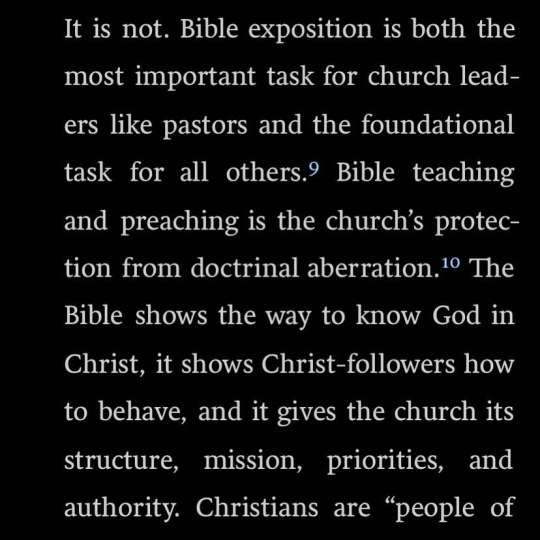
#KnowYourBible #StudyYourBible #Bible #BibleInstitute #TeachTheWord #PreachTheWord #BiblicalLanguages #Hebrew #Greek #BiblicalHebrew #BiblicalGreek https://www.instagram.com/p/B8xx1nogZPi/?igshid=8zs4jalj1zzx
#knowyourbible#studyyourbible#bible#bibleinstitute#teachtheword#preachtheword#biblicallanguages#hebrew#greek#biblicalhebrew#biblicalgreek
2 notes
·
View notes
Text
A Week in Review: 2/3/2019-2/9/2019
What is new at Anderson Theology this week:
Apologetics page updated.
Biblical Archaeology page created.
Biblical Archaeologists page created.
Biblical Theology page updated.
Biblical Greek page updated.
Biblical Texts page created.
The Nicene and Post-Nicene Fathers (A.D. 325-600) page updated.
St. Jerome (c. A.D. 345-420) page created.
Sozomen (early 5th century) page created.
The Medieval…
View On WordPress
#AlexanderCruden#AndersonTheology#Apologetics#BiblicalArchaeologists#BiblicalArchaeology#BiblicalGreek#BiblicalTexts#BiblicalTheology#EThomasAnderson#FrederickHenryAmbroseScrivener#JohnWycliffe#MedievalTheologians#ModernTheologians#Sozomen#StJerome#WilliamTyndale
1 note
·
View note
Text
"Κύριε…σύ γινωσκεις ότι φιλω σε."
"Lord, you know I love you."
2 notes
·
View notes
Text
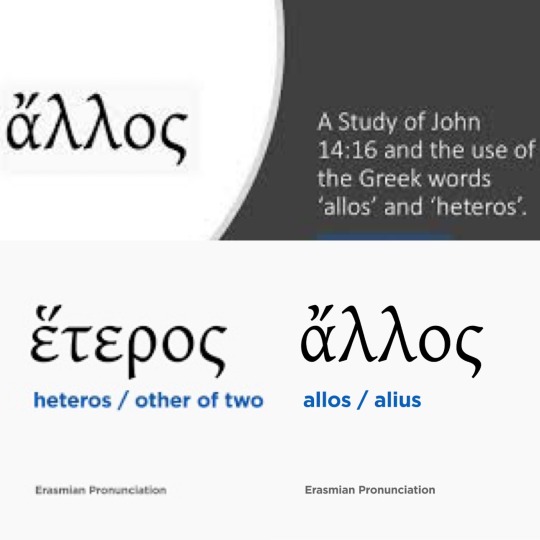
The Use of ἄλλος and έτερος in the New Testament
By Author & Bible Researcher Eli Kittim 🎓
The Greek terms ἄλλος (allos) and ἕτερος (heteros) primarily mean “other,” or “another.” The standard koine Greek teaching that the definitions of the words ἄλλος and ἕτερος are qualitatively different has been taught throughout the world in many seminaries, universities, and Bible institutes. The difference between the two words is often explained as follows: állos means “another of the same kind,” whereas héteros means another “of a different kind.” Therefore, entrenched in Biblical scholarship is the notion that ἄλλος and ἕτερος are qualitatively *different* terms.
However, according to a published article by Dr. James Keith Elliott——Emeritus Professor of New Testament Textual Criticism at the University of Leeds——the terms ἄλλος and ἕτερος are essentially interchangeable and synonymous. Dr. Elliott writes:
Ετερος in Classical Greek is used of
division into two parts: in New Testament
Greek the sense of the dual has largely
disappeared and έτερος is often confused
with άλλος. Attempts by commentators and
grammars to differentiate the two words
are often strained. In the New Testament
the words are interchangeable and
synonymous as can be seen most clearly at
I Cor 12 10 … and Hbr 11 35-36.
(James Keith Elliott, “The Use of έτερος in
the New Testament,” Zeitschrift für die
neutestamentliche Wissenschaft [Vol. 60,
Issue 1-2, 1969]).
What Dr. Elliott is saying is that the aforesaid distinction in Classical Greek largely disappeared in New Testament times. He insists that the “attempts by commentators and grammars to differentiate the two words are often strained.” He asserts that the two “words are interchangeable and synonymous.” Let’s take a look at one example which, he claims, proves this point. It is a passage where Paul enumerates the various charismatic gifts that the Holy Spirit gives to believers for the purpose of building up the “church.” 1 Cor. 12.10-11 (SBLGNT) reads:
ἄλλῳ ἐνεργήματα δυνάμεων, ἄλλῳ
προφητεία, ἄλλῳ διακρίσεις πνευμάτων,
ἑτέρῳ γένη γλωσσῶν, ἄλλῳ ἑρμηνεία
γλωσσῶν · πάντα δὲ ταῦτα ἐνεργεῖ τὸ ἓν
καὶ τὸ αὐτὸ πνεῦμα, διαιροῦν ἰδίᾳ ἑκάστῳ
καθὼς βούλεται.
Translation (NRSV):
to another the working of miracles, to
another prophecy, to another the
discernment of spirits, to another various
kinds of tongues, to another the
interpretation of tongues. All these are
activated by one and the same Spirit, who
allots to each one individually just as the
Spirit chooses.
Notice that “all these [gifts] are activated by one and the same Spirit.” So we are not talking about qualitative differences “of a different kind.” Observe also that the two words ἄλλῳ and ἑτέρῳ are used as interchangeable and synonymous terms! The aforementioned distinction between ἄλλος “of the same kind” versus έτερος “of a different kind” doesn’t apply in this particular context. Let’s now look at the second example, which Dr. James Keith Elliott provides, namely, Heb. 11.35-36:
ἔλαβον γυναῖκες ἐξ ἀναστάσεως τοὺς
νεκροὺς αὐτῶν · ἄλλοι δὲ ἐτυμπανίσθη��αν,
οὐ προσδεξάμενοι τὴν ἀπολύτρωσιν, ἵνα
κρείττονος ἀναστάσεως τύχωσιν · ἕτεροι δὲ
ἐμπαιγμῶν καὶ μαστίγων πεῖραν ἔλαβον, ἔτι
δὲ δεσμῶν καὶ φυλακῆς ·
Translation:
Women received their dead by resurrection.
Others were tortured, refusing to accept
release, in order to obtain a better
resurrection. Others suffered mocking and
flogging, and even chains and
imprisonment.
In this pericope, the author of Hebrews is praising the giants of faith who were all unquestionably “of one kind,” and “not of another.” But notice that in discussing the faith of the Patriarchs——who were afflicted, persecuted, and tortured——the words ἄλλοι and ἕτεροι are used interchangeably. The people thus described are not qualitatively different. On the contrary, they are of the same kind: the heroes of faith! Once again, the assumed qualitative distinction between ἄλλοι and ἕτεροι does not exist.
In many instances, Dr. James Keith Elliott says that “scribes simply replace έτερος by άλλος.” For example, at Mt 10.23 some manuscripts read έτέραν, “but most Greek witnesses read άλλην.“ Mt. 10.23 reads:
ὅταν δὲ διώκωσιν ὑμᾶς ἐν τῇ πόλει ταύτῃ,
φεύγετε εἰς τὴν ἑτέραν · ἀμὴν γὰρ λέγω
ὑμῖν, οὐ μὴ τελέσητε τὰς πόλεις τοῦ
Ἰσραὴλ ἕως ἂν ἔλθῃ ὁ υἱὸς τοῦ ἀνθρώπου.
Translation:
When they persecute you in one town, flee
to the next; for truly I tell you, you will not
have gone through all the towns of Israel
before the Son of Man comes.
Dr. Elliott argues that “In both places έτέραν is used in a non Classical way and is likely therefore to be what the original author wrote.” Elliott points to similar variants that occur for the same reasons in Lk. 10.1 (άλλους); Acts 8.34 (άλλον); Lk. 14.20 (άλλος); Lk. 4.43 (έτερος); Lk. 11.26 (ἕτερα); Lk. 22.65 (ἕτερα); and Jn 9.9 (ἄλλοι). In other words, in New Testament times, άλλην and έτέραν are seen as interchangeable and synonymous terms. Elliott writes:
At Lc 16 18 some mss. read άλλην for
an original έτέραν where assimilation to Mt
19 9 and Mc 10 11 may have been
responsible for the variant. This parallel
shows how easily έτερος and άλλος were
interchangeable within the New Testament
period itself.
If that’s the case, then let’s look at Lk. 16.18, which uses the word ἑτέραν:
Πᾶς ὁ ἀπολύων τὴν γυναῖκα αὐτοῦ καὶ
γαμῶν ἑτέραν μοιχεύει, καὶ ὁ ἀπολελυμένην
ἀπὸ ἀνδρὸς γαμῶν μοιχεύει.
Translation:
Anyone who divorces his wife and marries
another commits adultery, and whoever
marries a woman divorced from her
husband commits adultery.
Now let’s compare Lk. 16.18 to a parallel passage, Mt 19.9, which uses the alternative term ἄλλην. Mt. 19.9 says thusly:
λέγω δὲ ὑμῖν ὅτι ὃς ἂν ἀπολύσῃ τὴν
γυναῖκα αὐτοῦ μὴ ἐπὶ πορνείᾳ καὶ γαμήσῃ
ἄλλην μοιχᾶται καὶ ὁ ἀπολελυμένην
γαμήσας μοιχᾶται.
Translation:
And I say to you, whoever divorces his wife,
except for unchastity, and marries another
commits adultery.
Notice how ἑτέραν in Lk. 16.18 becomes ἄλλην in Mt. 19.9, which demonstrates that the two terms are indeed interchangeable. Let’s also follow Elliott’s advice and compare yet another parallel, namely, Mk. 10.11:
καὶ λέγει αὐτοῖς · Ὃς ἂν ἀπολύσῃ τὴν
γυναῖκα αὐτοῦ καὶ γαμήσῃ ἄλλην μοιχᾶται
ἐπ’ αὐτήν.
Translation:
He said to them, ‘Whoever divorces his wife
and marries another commits adultery
against her.’
Let’s now explore a different set of passages. Specifically, let’s look at Lk 8.6 and compare it to the parallel passage in Mk. 4.5. Lk 8.6 employs the term ἕτερον and reads as follows:
καὶ ἕτερον κατέπεσεν ἐπὶ τὴν πέτραν, καὶ
φυὲν ἐξηράνθη διὰ τὸ μὴ ἔχειν ἰκμάδα.
Translation:
Some fell on the rock; and as it grew up, it
withered for lack of moisture.
However, the parallel passage in Mk. 4.5 uses the word ἄλλο instead. It reads:
καὶ ἄλλο ⸃ ἔπεσεν ἐπὶ τὸ πετρῶδες ὅπου
οὐκ εἶχεν γῆν πολλήν, καὶ εὐθὺς
ἐξανέτειλεν διὰ τὸ μὴ ἔχειν βάθος γῆς ·
Translation:
Other seed fell on rocky ground, where it did
not have much soil, and it sprang up
quickly, since it had no depth of soil.
Elliott also adds Mt. 13.5 (ἄλλα) to the mix as a counterpoint:
ἄλλα δὲ ἔπεσεν ἐπὶ τὰ πετρώδη ὅπου οὐκ
εἶχεν γῆν πολλήν, καὶ εὐθέως ἐξανέτειλεν
διὰ τὸ μὴ ἔχειν βάθος γῆς.
Translation:
Other seeds fell on rocky ground, where
they did not have much soil, and they
sprang up quickly, since they had no depth
of soil.
Let’s now examine a completely different set of parallel passages and verbal agreements. According to Elliott, “at Mt. 16.14b έτεροι is read where the parallel passages in Mc 8 28 and Lc 9 19 read άλλοι.” So, let’s take a quick look at these final examples before we end our study. Mt. 16.14 uses both words (ἄλλοι and ἕτεροι) and says:
οἱ δὲ εἶπαν · Οἱ μὲν Ἰωάννην τὸν βαπτιστήν,
ἄλλοι δὲ Ἠλίαν, ἕτεροι δὲ Ἰερεμίαν ἢ ἕνα
τῶν προφητῶν.
Translation:
And they said, ‘Some say John the Baptist,
but others Elijah, and still others Jeremiah
or one of the prophets.’
Notice that the parallel passage in Mk. 8.28 uses ἄλλοι in the same place where Mt. 16.14 used ἕτεροι. Mk 8.28 reads as follows:
οἱ δὲ εἶπαν αὐτῷ λέγοντες ⸃ ὅτι Ἰωάννην
τὸν βαπτιστήν, καὶ ἄλλοι Ἠλίαν, ἄλλοι δὲ
ὅτι εἷς ⸃ τῶν προφητῶν.
Translation:
And they answered him, ‘John the Baptist;
and others, Elijah; and still others, one of
the prophets.’
Lk. 9.19 is yet another parallel passage which uses the variant ἄλλοι. Lk. 9.19 reads:
οἱ δὲ ἀποκριθέντες εἶπαν · Ἰωάννην τὸν
βαπτιστήν, ἄλλοι δὲ Ἠλίαν, ἄλλοι δὲ ὅτι
προφήτης τις τῶν ἀρχαίων ἀνέστη.
Translation:
They answered, ‘John the Baptist; but
others, Elijah; and still others, that one of
the ancient prophets has arisen.’
Conclusion
Based on the numerous parallel passages that we studied, it is quite obvious that the Classical Greek qualitative distinction between άλλος and έτερος had largely disappeared in New Testament times. As can be seen from the previous New Testament examples, and from Dr. James Keith Elliott’s study, the words άλλος (allos) and έτερος (heteros) are interchangeable and synonymous terms!
#Greekstudy#Greekexegesis#textualcriticism#G2087#commonAttic#ΕλληνιστικήΚοινή#parallelpassages#Bibleexegesis#KoineGreek#attic greek#elikittim#Alexandriandialect#το μικρό βιβλίο της αποκάλυψης#εκ#James_Keith_Elliott#ek#G243#classical greek#ἄλλος#έτερος#thelittlebookofrevelation#BiblicalGreek#wordstudies#HellenisticGreek#ελικιτίμ#crossreferences#HellenisticKoine#Biblicalparallels#Bibleconcordance#NewTestamentGreek
6 notes
·
View notes
Text
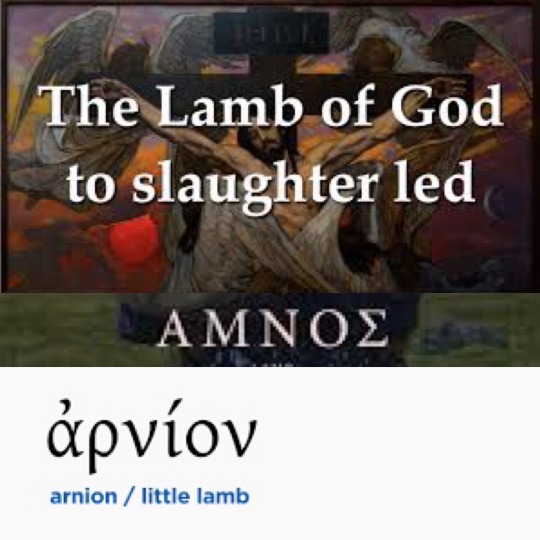
🔎 Bible Contradictions: In Using the Term “Arnion,” Does the Book of Revelation Contradict John’s Gospel Which Uses the Word “Amnos” Instead? 🔍
By Award-Winning Goodreads Author and Bible Researcher Eli Kittim 🎓
This short essay is a brief reply to a question that was posed by a member of my “Eli Kittim Theology” group on MeWe.
——-
The member’s name is Marlo Bliss. This was his Question:
The writer of the Book of Revelation used
the term "Lambkin" / ARNI'ON <G721> for
Jesus Christ instead of "lamb" / AMNO'S <>
(lambkins require feeding). He did so 26
times. Why this contradiction to John 1.29
and 1.36?
Thanks for any reply.
*I use the DLT (Dabhar Literal Translation)
software in hebrew, greek, english and
german.*
——-
He’s basically asking the following question: if John’s Gospel uses the Greek term Ἀμνὸς twice to refer to Jesus, then why does the Book of Revelation repeatedly use the word ἀρνίον instead? Isn’t that a deviation from the canonical context? Doesn’t that constitute a Biblical contradiction? The implication is that the Book of Revelation appears to be wrong and contradictory in its terminological usage.
First of all, it is important to establish at the outset that both ἀμνός (amnós) and ἀρνίον (arníon) mean the same thing. These terms are not self-contradictory, but rather interchangeable and complementary. Whereas **ἀμνός** (amnós) has the connotation of a consecrated or sacrificial lamb, especially a one-year old lamb, **ἀρνίον** refers to a “little lamb,” under a year old (Henry George Liddell. Robert Scott. A Greek-English Lexicon. Oxford. Clarendon Press. 1940). According to J. Thayer, the connotation of ἀρνίον (arníon) is that of pure innocence, with virgin-like (gentle) intentions.
Second, John’s Gospel uses both amnós and arníon. It’s true that John chapter 1 and verses 29 & 36 use the term Ἀμνὸς (lamb) to refer to Jesus Christ. But this term occurs only twice. And yet, the exact same gospel of John uses the alternative ἀρνία (lambs) in chapter 21 verse 15—-which is the plural form of the singular term ἀρνίον (lamb)——to refer to the *Christ-like* followers, namely, the saints of God who are becoming like Christ.
Third, the use of the word ἀρνίον (arníon) in a “messianic canonical context” is in fact scriptural, as can be seen, for example, in the Book of Jeremiah. In Jeremiah 11.19, the Septuagint (LXX) uses the Greek term ἀρνίον in an overtly messianic context:
ἐγὼ δὲ ὡς ἀρνίον ἄκακον ἀγόμενον τοῦ
θύεσθαι οὐκ ἔγνων ἐπ᾽ ἐμὲ ἐλογίσαντο
λογισμὸν πονηρὸν λέγοντες δεῦτε καὶ
ἐμβάλωμεν ξύλον εἰς τὸν ἄρτον αὐτοῦ καὶ
ἐκτρίψωμεν αὐτὸν ἀπὸ γῆς ζώντων καὶ τὸ
ὄνομα αὐτοῦ οὐ μὴ μνησθῇ ἔτι.
English translation by L.C.L. Brenton:
But I as an innocent lamb led to the
slaughter, knew not: against me they
devised an evil device, saying, Come and let
us put wood into his bread, and let us
utterly destroy him from off the land of the
living, and let his name not be remembered
any more.
This is reminiscent of Isaiah 53. In fact, Jeremiah’s aforementioned verse is a parallel to——and presents a near-verbal agreement with——Isaiah 53.7 (LXX):
καὶ αὐτὸς διὰ τὸ κεκακῶσθαι οὐκ ἀνοίγει
τὸ στόμα· ὡς πρόβατον ἐπὶ σφαγὴν ἤχθη
καὶ ὡς ἀμνὸς ἐναντίον τοῦ κείροντος αὐτὸν
ἄφωνος οὕτως οὐκ ἀνοίγει τὸ στόμα
αὐτοῦ.
Translation (NRSV):
He was oppressed, and he was afflicted,
yet he did not open his mouth; like a lamb
that is led to the slaughter, and like a sheep
that before its shearers is silent, so he did
not open his mouth.
In Jeremiah 11.19, the L.C.L. Brenton translates ἀρνίον “as an innocent lamb led to the slaughter,” while the NRSV similarly renders it as a “gentle lamb led to the slaughter.” The theological idea in Jeremiah 11.19 is consistent with that of Isaiah 53.7—-which says “like a lamb that is led to the slaughter”——even though Isaiah employs the terms πρόβατον (lamb) and ἀμνὸς (sheep) instead of Jeremiah’s use of the word ἀρνίον (lamb). These thematic parallels demonstrate that the above terms are interchangeable.
Thus, the Septuagint (LXX) uses 3 alternative terms to refer to this so-called messianic “lamb” of God who “was wounded for our transgressions, crushed for our iniquities; … and by his bruises we are healed” (Isaiah 53.5). Two of the three terms that the LXX uses for this *slaughtered messiah* are found in Isaiah 53.7, namely, πρόβατον and ἀμνὸς. Incidentally, πρόβατον (probaton) means ἀρνίον, which comes from ἀρήν (meaning “lamb”). Thus, ἀμνός (amnós), πρόβατον (próbaton), and ἀρνίον (arníon) are essentially interchangeable terms.
The word πρόβατον (probaton), which means ἀρνίον, is also used in Gen 22.8 by the LXX to refer to the sacrificial lamb of God:
Abraham said, ‘God himself will provide the
lamb for a burnt offering, my son.’ (NRSV)
The Septuagint also uses the Greek term πρόβατον (which means ἀρνίον) to refer to the sheep which is slaughtered as a “sin offering” in Lev 4.32.
Therefore, the Book of Revelation uses the exact same term that is found not only within the Biblical canonical-context itself (Jn 21.15), but also within the writings of the Septuagint as well. So how is it contradictory? It is not!
Conclusion
As you can see, the way in which the Koine Greek language has been used in both the Septuagint (LXX) and the New Testament clearly shows that the words ἀμνός (amnós), πρόβατον (próbaton), and ἀρνίον (arníon) are essentially interchangeable and complementary terms. These 3 words have all been used in terms of a “messianic sin offering,” that is, in reference to an innocent lamb that is led to the slaughter (cf. Rev. 5.6 ἀρνίον ἑστηκὸς ὡς ἐσφαγμένον/“a Lamb standing as if it had been slaughtered”). Although these terms have slightly different nuances, nevertheless they have been used consistently within a “messianic scriptural context” across the board. This is based on the principle of expositional constancy, the idea that similar terms and images are used consistently throughout scripture.
Since most scholars don’t think that John’s Gospel and the Book of Revelation were written by the same author, this would explain why they don't use the exact same terminology. Different biblical authors use different vocabularies. This fact alone doesn’t preclude their books from being seen as authoritative or inspired. On the contrary, if we look at the 27 New Testament books, this seems to be the rule rather than the exception!
Thus, Mr. Marlo Bliss’ accusation——that “the writer of the Book of Revelation [who] used the term "Lambkin" / ARNI'ON … for Jesus Christ instead of "lamb" / AMNO'S” was contradicting “John 1.29 and 1.36”——is unwarranted and without merit!
Incidentally, I looked at the so-called “DLT” (Dabhar Literal Translation) that Mr. Bliss uses, but unfortunately it is not faithful to the original Greek New Testament text. Besides, there is no disclosure or commentary about which text-types were used or if there even was a committee of scholars who edited it, which I seriously doubt, given the poor quality of the translation. I’ve also come across some YouTube videos, that are put out by the same sect, which endorse the Dabhar Literal Translation. Unfortunately, this English translation is of an inferior quality. Adherents of this cult further claim that the Book of Revelation is a “spurious” book. This sounds like a sect that has drifted away from sound Bible teaching!
——-
#lamb of god#questions and answers#ἀρνίον#πρόβατον#ἀμνός#agnus dei#Elikittimtheologygroup#mewe.com#book of revelation#gospel of john#LCLBrentontranslation#elikittim#the little book of revelation#ek#lxx#septuagint#old testament#ελικιτίμ#ΕλληνιστικήΚοινή#το μικρό βιβλίο της αποκάλυψης#BiblicalGreek#εκ#NewTestamentGreek#KoineGreek#bible translation#bibleexegesis#HellenisticGreek#Biblecontradictions#christian apologetics#JesusLambOfGod
6 notes
·
View notes
Text

Both Iris & Toxon mean Rainbow in the Bible
By Eli Kittim 🎓
All the Evidence Points to a Christ-Like Figure in Rev. 6.2
In this study I want to focus primarily on two words, iris & toxon, in order to show how they completely change our understanding of Revelation 6.2. But before I do this, I would first like to show you some proofs concerning the implied benevolence of the White horseman of the Apocalypse. That the white horse is a symbol of purity and righteousness is multiply attested by its linguistic usage patterns. For example, the phrase “and behold, a white horse,” in Rev. 19.11, is identical to the one used in Revelation 6.2. In other words, the two white horses of Revelation 19 & 6 represent the exact same figure who “is called Faithful and True” (Rev. 19.11)! That’s why Irenaeus, a second century theologian, held the same view, namely, that the first rider of the white horse who is depicted as a peacemaker represents Jesus Christ (Mounce, Robert H. The Book of Revelation. New International Commentary on the New Testament. Rev. ed. [Grand Rapids: Eerdmans, 1997], p. 141).
This is also confirmed by the type of crown the rider of the white horse wears. Stephanos “crowns” are typically worn by believers and victors in Christ (see e.g. the Greek text of Matthew 27.29; James 1.12; 2 Timothy 4.8; 1 Peter 5.4; Revelation 2.10; 4.4; 14.14)! All these proofs clearly show that the white horseman of Rev. 6.2 is neither deceptive nor evil, as many Bible commentators would have us believe!
The Hebrew Bible Uses the Word Bow for Rainbow
In the New Testament, the Greek noun ἶρις (iris) means “rainbow” (see https://biblehub.com/greek/2463.htm). Curiously enough, the Greek noun τόξον (toxon), which we find in Rev. 6.2, means “bow” but——as we shall see——it also means “rainbow” (see https://biblehub.com/greek/5115.htm). Τόξον can be seen as a contraction for ουράνιον τόξον (rainbow), from Ancient Greek οὐρανός ("heaven") + τόξον ("bow").
Given that the Greek noun “iris” is the most widely used term for “rainbow” in the New Testament, some commentators argue that since the word in Rev. 6.2 is “toxon,” not “iris,” it means that “toxon” (τόξον) cannot possibly refer to a rainbow. However, many notable Bible commentators, such as Chuck Missler, have said that the “bow” (toxon) in Rev. 6.2 appears to represent the “rainbow” of Genesis 9.13. In other words, the bow (toxon) represents the peace-covenant of Genesis 9.13. The actual verse in Genesis 9.13 (NRSV) reads:
“I have set my bow in the clouds, and it shall be a sign of the covenant between me and the earth.”
Bear in mind that Genesis 9.13 uses the Hebrew phrase qaš·tî (קַשְׁתִּ֕י), which means “my bow.” It comes from the Hebrew noun קֶשֶׁת (qesheth), which means——wait for it——a bow (https://biblehub.com/hebrew/7198.htm).
The Septuagint (LXX) Translates the Hebrew Word for Rainbow with the Greek Word Toxon
Further evidence that “toxon” (bow) can mean “rainbow” comes from the Septuagint, an early Greek translation of the Hebrew Bible. Lo and behold, the Septuagint translates “rainbow” as τόξον (toxon) in Genesis 9.13!
Thus, this brief study illustrates my point, namely, that “iris” and “toxon” are interchangeable in the Bible! The Septuagint (LXX) translation of Genesis 9.13 by L.C.L. Brenton reads as follows:
τὸ τόξον μου τίθημι ἐν τῇ νεφέλῃ, καὶ ἔσται εἰς σημεῖον διαθήκης ἀνὰ μέσον ἐμοῦ καὶ τῆς γῆς.
Translation:
“I set my bow in the cloud, and it shall be for a sign of covenant between me and the earth.”
Conclusion
Therefore, both “iris” and “toxon” mean “rainbow” in the Bible! They are interchangeable terms. This means that the rider of the “white horse … [who] had a bow” (τόξον), in Rev. 6.2, is symbolically holding the “rainbow,” which represents the covenant of peace between God & man in Genesis 9.13!
#apologetics#iris#toxon#rainbow#bow#Genesis9v13#HebrewBible#septuagint#biblical hebrew#biblicalGreek#bible translations#biblical exegesis#thelittlebookofrevelation#biblicalinterpretation#ελικιτίμ#Revelation6v2#GreekNewTestament#το μικρό βιβλίο της αποκάλυψης#lxx#stephanos#elikittim#white horse#NewTestamentlinguistics#irenaeus#Christ#crossreferences#ChuckMissler#koineGreek#classicalHebrew#whitehorseofrevelation
9 notes
·
View notes
Photo
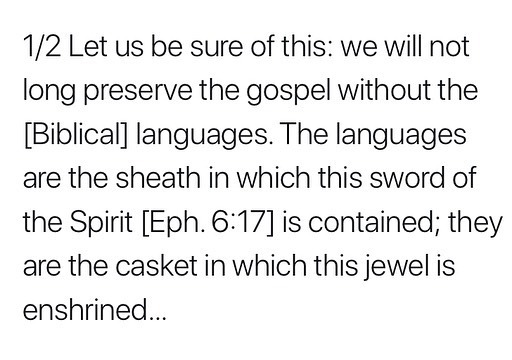
#BiblicalLanguages #BiblicalHebrew #BiblicalGreek #Study #MinisterialResponsibility #aPastorsDuty #itsallaboutheBible #PrivilegetheBible #OriginalWord #Biblemanuscripts #PrivilegetheText #WhatGodinspired #EvenLuthercanberight https://www.instagram.com/p/B1zzNA0AI_s/?igshid=t6iy818xdz2g
#biblicallanguages#biblicalhebrew#biblicalgreek#study#ministerialresponsibility#apastorsduty#itsallabouthebible#privilegethebible#originalword#biblemanuscripts#privilegethetext#whatgodinspired#evenluthercanberight
2 notes
·
View notes
Text
The Septuagint's Translation of Daniel 12.1-2 Suggests an Eschatological Messianic Resurrection
By Author Eli Kittim
The Hebrew name מִיכָאֵל (i.e. Mikha'el) means "who is like God?". It is a rhetorical question, the implication of which is that no person is like God. Interestingly enough, the biblical terminology used to describe Michael is often similar to that of the Messiah. For example, "the archangel Michael" (Jude 1.9), who is described in the Old Testament as "one of the chief princes" (Dan. 10.13), is clearly identified with Christ the "anointed prince" (Dan. 9.25) in 1 Thess. 4.16:
"For the Lord himself, with a cry of command, with the archangel's call and with the sound of God's trumpet, will descend from heaven, and the dead in Christ will rise first" (NRSV).
In Dan. 12.1 there is a reference to a great prince named Michael, depicted as "the protector of your people," who “shall arise” during the time of the great ordeal (i.e. the great tribulation).
The so-called ‘Theodotion Daniel’ form of the LXX translates the Hebrew term עָמַד aw-mad (i.e. "shall arise") as *ἀναστήσεται*, meaning a bodily resurrection.
The Theodotion Daniel (Δανιηλ 12.1) reads:
Καὶ ἐν τῷ καιρῷ ἐκείνῳ ἀναστήσεται Μιχαήλ ὁ ἄρχων ὁ μέγας, ὁ ἑστηκὼς ἐπὶ τοὺς υἱοὺς τοῦ λαοῦ σου· καὶ ἔσται καιρὸς θλίψεως, θλίψις οἵα οὐ γέγονεν ἀφ’ οὗ γεγένηται ἔθνος ἐν τῇ γῇ, ἕως τοῦ καιροῦ ἐκείνου·
Translation:
"At that time Michael, the great prince, the protector of your people, shall arise. There shall be a time of anguish, such as has never occurred since nations first came into existence" (NRSV).
The Old Greek (LXX) goes on to say:
καὶ πολλοὶ τῶν καθευδόντων ἐν τῷ π��άτει τῆς γῆς ἀναστήσονται, οἱ μὲν εἰς ζωὴν αἰώνιον, οἱ δὲ εἰς ὀνειδισμόν, οἱ δὲ εἰς διασπορὰν καὶ αἰσχύνην αἰώνιον (Dan. 12.2).
It is translated as follows:
"Many of those who sleep in the dust of the earth shall awake, some to everlasting life, and some to shame and everlasting contempt" (NRSV).
The word *ἀναστήσεται* is the future middle indicative from ἀνίστημι, which is the root word of *ἀνάστασις* and means to ‘raise up’ or to 'raise from the dead.' Accordingly, notice how the term *ἀναστήσεται* in its singular and plural form conveys the meaning of resurrection. In the Th Dan. 12.1, we have the singular form *ἀναστήσεται* ("shall arise"). Similarly, *ἀναστήσονται* (the plural form in the OG Dan. 12.2) represents an explicit reference to a resurrection from the dead, thereby establishing its meaning. And since both of these resurrection events (namely, Michael's resurrection followed by the general resurrection of the dead) are set for "the time of the end" (Dan. 12.4), the implication is that they are eschatological in nature!

#LXX#ἀνίστημι#resurrection#biblicalgreek#septuagint#Theodotion#daniel12v1#daniel12v2#ἀναστήσεται#ἀναστήσονται#biblestudy#eschatology#bibletranslation#shallarise#scholarlystudies#KoineGreek#Eli_of_Kittim_Bible_Exegesis_Group#EK#Author EK#EK ministry#ek ministries#eli kittim ministry#eli kittim ministries#ministry of kittim#ministries of kittim#eli of kittim ministry#eli of kittim ministries
5 notes
·
View notes
Photo

#BiblicalGreek #BiblicalLanguages #Bible #LearningGreek #Hermeneutics #PentecostalAcademics https://www.instagram.com/p/CGtfTR4gN7e/?igshid=12hf05wpbt1zz
1 note
·
View note